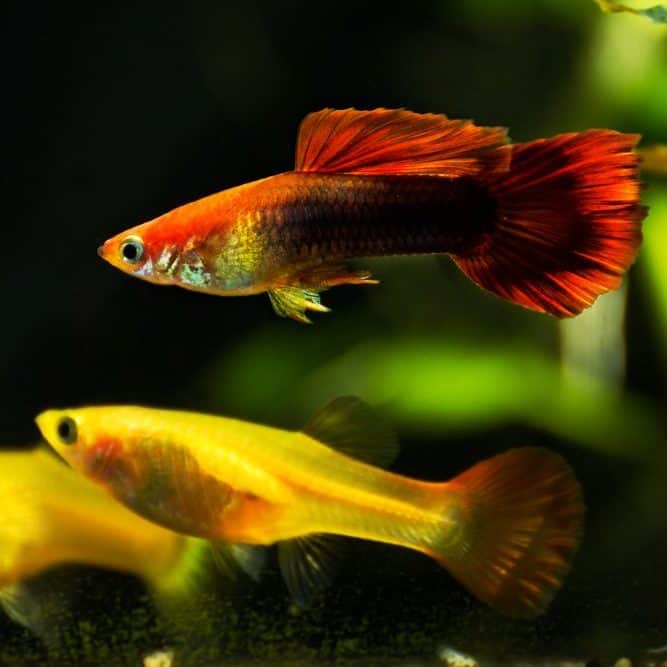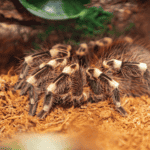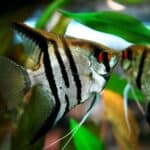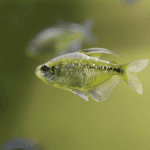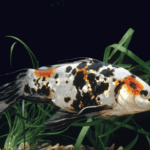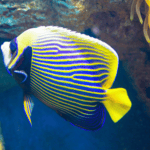Guppies are a popular choice among aquarium enthusiasts, not only for their vibrant colors and fascinating behavior, but also for their relatively manageable care requirements. As we explore the lifespan of guppies, it’s important to recognize that various factors can influence how long these captivating creatures live.
Typically, a guppy’s lifespan ranges between 1 and 3 years. However, by providing optimal living conditions, proper nutrition, and diligent care, we can extend their lifespans to about 5 years. In the following paragraphs, we will discuss the factors that contribute to the longevity and overall health of these remarkable fish.
Guppy Life Span
Guppies are small, colorful fish that are popular among hobbyists. In ideal conditions, their average life span ranges from 1 to 3 years. However, various factors can impact their longevity. We will discuss some key aspects to maintain the health and ensure a long life for our guppies.
Keeping a clean and well-maintained aquarium is crucial for their well-being. A balanced environment significantly contributes to our guppies’ health, reducing stress and promoting a longer life span. Regular water changes, adequate filtration, and appropriate water parameters can help in achieving this.
Food plays a major role in our guppies’ life. Providing a varied, high-quality diet not only ensures they get essential nutrients but also helps prevent overfeeding, which can be harmful. Feed them small amounts, preferably two to three times a day, but never too much, as excessive food can lead to obesity and impact their overall health.
Stress is a major factor that can shorten our guppies’ life. Fluctuations in water temperature, poor water quality, aggression from other fish, or overcrowding can increase stress levels. Keeping the aquarium spacious and peaceful with compatible tank-mates, along with regular monitoring, can help address these issues.
Finally, it is essential to note that guppies, like all organisms, mature and age. As they grow older, their metabolism slows down, making them more susceptible to illnesses. It is important to provide consistent care and attention to ensure our guppies live healthy and happy lives throughout their life span.
Guppies as Pets
Guppies are an excellent choice for both beginner and experienced aquarium enthusiasts. They are hardy, colorful, and easy to care for, which is why we often recommend them to new pet owners. As long-time guppy caretakers, our experience has taught us that a well-kept home aquarium can house these delightful little creatures for a lifespan of one to three years.
To ensure the longevity of your guppies, it is vital that we provide them with a comfortable living environment. This typically starts with an aquarium size of at least 10 gallons. If you want to add more guppies or other community fish, you might consider increasing the size of your tank. Another important aspect is water quality. We advise checking the pH, ammonia, nitrite, and nitrate levels regularly. The ideal temperature for a guppy’s home is between 72°F to 78°F.
When it comes to feeding these lively swimmers, they are not picky eaters. We have found that a balanced diet consisting of high-quality tropical fish flakes, shrimps, or bloodworms will provide all the essential nutrients for guppies to thrive. Feeding them small portions one to two times a day is ideal. This will ensure that you avoid overfeeding, which can lead to poor water quality and health issues.
Another aspect to consider is the social nature of guppies. They are a schooling fish, meaning they prefer to live in groups. So, it is best to keep at least three to five guppies together in your aquarium. Introducing other compatible species like platies, mollies, or tetras can also add variety and excitement to your underwater community.
In conclusion, guppies are charming and low-maintenance pets that can bring joy and beauty to any home aquarium. By providing the necessary care and attention, we can create an environment in which our guppies can thrive and reach their full potential.
Understanding Guppy Species
We find that guppy fish are a diverse and fascinating species. They are known for their vibrant colors and unique patterns, which make them popular among aquarium enthusiasts. Guppies belong to the Poecilia reticulata species and are native to South America.
In the wild, guppies exhibit a range of colors, including metallic blues, greens, silvers, and yellows. However, due to selective breeding, various other colors and patterns have been developed in domesticated guppies. These captive-bred guppies often display stunning color combinations, making them a favorite choice for home aquariums.
Male guppies, in particular, showcase more intricate patterns and vibrant colors compared to their female counterparts as a means of attracting mates. Females, on the other hand, are typically larger, have a more muted color palette, and possess a rounded, gravid spot near their anal fin. This feature allows us to easily distinguish between the sexes.
It is essential to be aware of the different aspects of guppy species, not only for appreciating their beauty but also for providing proper care and understanding their behavior. By being knowledgeable about their characteristics, we can ensure that our guppy fish thrive in their aquatic environment.
Guppy Breeding
We understand that guppy breeding can be both exciting and rewarding. Guppies are livebearers, which means the females give birth to live offspring rather than laying eggs. When breeding guppies, it’s essential to be familiar with the basic principles of their genetics and reproductive process.
One of the main factors to consider when breeding guppies is selecting the best individuals. As breeders, we need to examine the traits we want to pass down to future generations, such as color, fin shape, and size. Guppies exhibit a wide range of colors and patterns due to their diverse genetics. By selectively breeding for these traits, we can produce unique and attractive guppy strains.
The pregnancy period for guppies is relatively short, typically ranging from 21 to 30 days. The gestation period can vary depending on factors such as temperature and the female’s overall health. An important aspect to monitor during this time is the diet; providing pregnant guppies with a balanced diet ensures the optimal development of the offspring.
Once the female guppy gives birth, it’s crucial to separate the fry from the adults, as adult guppies can exhibit cannibalistic behavior towards their young. We can rear the fry in a separate tank with gentle filtration and an environment similar to that of the adult tank. As the fry grow, they may start displaying characteristics typical of the rainbow fish family, which guppies belong to.
To provide the fry with the best chance of survival, we need to maintain an appropriate feeding regimen. Newly-hatched fry benefit from a diet of infusoria or liquid fry food before transitioning to finely-ground flake food as they grow. Around 2 weeks old, the young guppies should have sufficiently developed swim bladders, which indicate they are ready to be introduced into a community setting.
In conclusion, successful guppy breeding requires a solid understanding of genetics, careful selection of the breeding pair, and dedication to fostering the proper environment and feeding regimen for both adult guppies and their offspring. With some patience and attention to detail, we can create stunning and healthy lines of guppies that will captivate aquatic enthusiasts for years to come.
Care and Maintenance
To ensure our guppies live long and healthy lives, we must pay close attention to their care and maintenance. A proper aquarium environment is crucial for their well-being. When setting up a tank, we should consider the size, water quality, temperature, and filtration.
An optimal tank size for guppies is at least 10 gallons to avoid overcrowding, which can be a major cause of stress and poor health. The water quality in the tank should be stable and include careful monitoring of parameters like pH, ammonia, nitrite, and nitrate levels. A pH between 6.8 and 7.8, ammonia and nitrite levels at 0 ppm, and nitrate below 20 ppm will help maintain healthy guppies.
Additionally, using a suitable filtration system will assist in keeping water quality high and consistent. This will minimize the buildup of harmful substances such as ammonia and nitrites, which can stress fish and cause illness. The water temperature must remain between 72°F and 82°F, as guppies are tropical fish and thrive in warmer waters.
Water hardness is another essential factor for guppy health. The preferred water hardness range is between 8-12 dGH. To help maintain ideal water conditions, we recommend using a water conditioner to remove chlorine and chloramine from tap water before adding it to the tank.
Incorporating live plants into the aquarium will not only improve the overall appearance but also contribute to better water quality. Guppies are omnivores and will occasionally nibble on live plants, which can supplement their diet.
Adequate lighting is crucial for guppies, as it stimulates their natural behaviors and overall well-being. We should provide 8-10 hours of light daily, ideally from an aquarium-specific light source.
When it comes to tank mates, it’s crucial to choose compatible species for our guppies to ensure a harmonious, stress-free environment. Some suitable tank mates include other small, non-aggressive tropical fish such as mollies, platies, and small species of tetras.
By following these guidelines, we can create a comfortable and thriving environment for our guppies, ensuring they live long and healthy lives.
Feeding Practices
As guppy enthusiasts, we know that feeding practices play a crucial role in the health and lifespan of these vibrant fish. Guppies are omnivores, which means they require a balanced diet containing both plant and animal matter. A varied diet ensures that they receive the necessary nutrients to maintain their health, vibrant colors, and active behavior.
We recommend providing a base diet of high-quality fish flakes formulated specifically for guppies. These flakes will contain essential nutrients and vitamins to help keep our fish healthy. Supplementing this base diet with live foods, such as brine shrimp, bloodworms, and daphnia, is an excellent way to cater to their preference for live prey and to mimic their natural feeding habits. We should aim to offer live foods once or twice a week.
In addition to fish flakes and live foods, it’s important to include fresh veggies in our guppies’ diet. Chopped, blanched vegetables like spinach, lettuce, and zucchini add variety to their dietary intake, simultaneously helping to maintain optimal health. When feeding, we should offer small amounts of food multiple times a day, ensuring that all particles are consumed within two minutes to avoid overfeeding.
It’s worth mentioning that the quality of food is essential for the well-being of our guppies. Providing high-quality food, whether flakes, live, or veggies, ensures they obtain optimal nutrition, leading to a healthier and potentially longer life. In conclusion, following these feeding practices is a key step in ensuring that our guppies lead a happy and fulfilling life.
Potential Health Issues
We should be aware of the potential health issues that guppies can face. One common problem is diseases caused by parasites or bacteria. Some of the most well-known diseases that affect guppies are fin rot, ich, and columnaris. To maintain a healthy immune system in our guppies, it’s important to monitor water quality and consider adding supplements to support their overall health.
Overfeeding not only results in polluted water due to increased waste output, but it also leads to obesity and stress. Feeding a balanced diet and maintaining a regular feeding schedule will help prevent these issues, ensuring our guppies remain healthy and active.
Stress plays a significant role in the health of guppies. Factors causing stress can include poor water quality, inadequate or overcrowded tanks, and sudden changes in temperature. We can minimize stress by keeping optimal water conditions, providing an appropriate habitat, and avoiding abrupt fluctuations in the aquarium environment.
In conclusion, by addressing potential health issues such as diseases, overfeeding, stress, and parasites, we can greatly improve the lifespan of our guppies. A healthy immune system is essential for combating these concerns, so maintaining proper care is crucial to ensuring our guppies stay healthy and thrive.
Guppies in their Natural Habitat
Guppies, also known as rainbow fish, are native to South America. They can be found in countries like Brazil, Guyana, and Barbados. In their natural habitat, these small, brightly colored freshwater fish often live in slow-moving rivers, streams, and ponds. Wild guppies play a significant role in their ecosystems and are an essential part of the food chain.
When we look at guppy populations, we notice that they tend to form shoals. This behavior helps them avoid predators such as cichlids, a type of aggressive fish that preys on guppies. The vibrant colors of guppies serve as a signal to predators that they are not an easy target. And when they stick together as a group, it becomes even more challenging for predators to single out and catch individual guppies.
As guppies live in freshwater environments, their natural habitat contains various vegetation or plants. These plants provide cover for guppies, allowing them to hide from predators, in addition to offering a source of food.
In captivity, guppies can live between 1 to 3 years on average, but in the wild, their lifespan tends to be shorter. This is mainly due to the various predators that exist in their natural habitat and the overall conditions of their environment. It is essential to keep these factors in mind when thinking about guppy populations in the wild.
In conclusion, it’s important to understand the natural habitat and behaviors of guppies to better care for them in a home aquarium. By mimicking elements of their wild environment and providing adequate space, nutrition, and companionship, we can increase the chances of our pet guppies living a long, happy life.
Frequently Asked Questions
What factors affect a guppy’s lifespan?
Several factors can impact the lifespan of guppies, including tank environment, water quality, diet, and genetics. Providing a stable, healthy environment with clean water, appropriate tank size, and a balanced diet significantly contributes to their overall longevity.
What is the average life expectancy of a female guppy?
The average life expectancy of a female guppy is 1.5 to 3 years, depending on various factors. However, it is essential to note that a female guppy’s lifespan can be impacted by regular breeding, as this can exhaust and deplete her energy, resulting in a shorter life.
How does tank size influence a guppy’s lifespan?
Tank size plays a significant role in a guppy’s lifespan. Inadequate space can lead to overcrowding, increased stress, and poor water quality, all of which can shorten guppy lifespans. We generally recommend a tank size of at least 5 to 10 gallons for a small group of guppies. Providing appropriate filtration and regular water changes will also contribute to a healthier tank environment.
Do different guppy strains have different lifespans?
Yes, different guppy strains can have different lifespans due to variations in their genetics. Some guppy strains are more robust and resilient, leading to longer lifespans, while others may be more susceptible to health issues or environmental stressors, resulting in shorter lifespans.
How does water quality impact guppy longevity?
Water quality is crucial for guppy health and longevity. Poor water quality can lead to stress, disease, and a shorter lifespan. We recommend maintaining appropriate temperature (72°F – 82°F), pH (6.8 – 7.8), and ammonia, nitrite, and nitrate levels. Regular water changes, proper filtration, and avoiding overfeeding will help maintain a healthy water environment.
What role does diet play in a guppy’s lifespan?
A balanced diet is essential for guppies to thrive and live a longer life. Providing them with high-quality, varied foods such as flakes, pellets, and live or frozen foods will ensure they receive all the necessary nutrients. Overfeeding can lead to poor water quality and obesity, so be mindful of portion sizes and feeding frequency.
